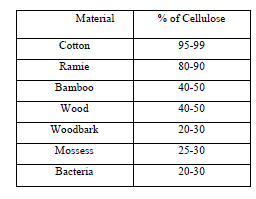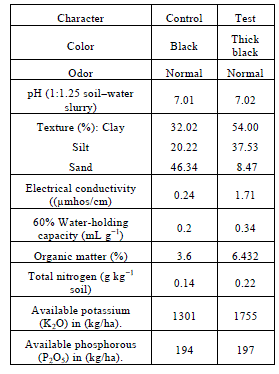ISSN ONLINE(2319-8753)PRINT(2347-6710)
ISSN ONLINE(2319-8753)PRINT(2347-6710)
K. Venkateswar Reddy1, T. Vijayalakshmi2, Archana Giri3, and A. Janaki Ganga Bhavani4
|
| Related article at Pubmed, Scholar Google |
Visit for more related articles at International Journal of Innovative Research in Science, Engineering and Technology
Effect of paper industry effluents on soil was assessed for physico-chemical and biological properties in the present study. Discharge of paper industry effluents onto the soil caused changes in physico-chemical and biological properties of soil. These changes include increase in clay and silt percentages, electrical conductivity, water holding capacity, organic matter, total nitrogen, available potassium and phosphorous in test over control sample. However, there was a less sand, higher bacterial and fungal populations were recorded in test soil. Also, bacteria degrading cellulose isolated from effluent polluted soil by enrichment method.
Keywords |
| Paper industry– Effluents – Physicochemical – Biological properties |
INTRODUCTION` |
| Paper industry is an agro based industry, effluents generating from this industry contain considerable amounts of organic and inorganic chemical components such as fibers, cellulosic wastes, wood dust, chlorine compounds, carbonates and bicarbonates [1]. Direct discharge of effluents from this industry may have profound influence of soil physico-chemical and biological properties. Though wealth of information on occurrence of changes in properties of soils due to discharge of effluents from other industries is available [2-9]. However, few researchers [10-14] emphasized in the area of screening of cellulose degrading microorganisms of polluted soil, and efficiency of their cellulase, since cellulase have significant role in different industries. Alarmingly, cellulose containing materials (Table I) can be used as one of the renewable energy sources, if microbial cellulase are properly used. In this direction, an attempt has therefore been made to find out the effects of effluents from paper industry on physico-chemical and biological properties of soil. Cellulose degrading bacteria from soils contaminated with effluents from paper industry were also isolated. |
MATERIAL AND METHODS |
| Soil contaminated with paper industry effluents was collected from A.P. Paper Mills Limited, located in Rajahmundry, East Godavari district of Andhra Pradesh, India (test soil). Soils from adjacent areas which were not contaminated with the paper industrial effluents were collected and are treated as control. These soil samples were air dried and mixed thoroughly to increase homogeneity and shifted through < 2 mm sieve. Physicochemical and biological properties of soil samples were determined by standard procedures. The soil particles like sand, silt and clay contents were analyzed with use of different sieves by the methods of Alexander [15]. Water-holding capacity, organic carbon, total nitrogen, and soluble phosphorous of soils with and without effluent contaminated were determined by the method of Jackson and Ulrich [16], Walkey-Black [17], Micro Kjeldhal [17] and Kuprevich and Shecherbakova [18], respectively. Electrical conductivity and pH were measured by Elico conductivity meter and pH meter, respectively. Biological properties of soil in terms of bacterial and fungal population were quantified by serial dilution techniques. Finally, cellulose degrading bacteria were isolated by using enrichment plating technique. |
RESULTS AND DISCUSSION |
| The analytical results of physico-chemical and biological parameters of both the test and control soils were presented in table II. Test soil samples underwent changes in all the measured parameters of physico-chemical and biological parameters in comparison to control soils. The soil texture in terms of percentages of clay, silt and sand were 54, 38, 8 and 32, 21 and 47 in test and control soil, respectively as shown in Table II. The above results indicated that soils contaminated with the effluents had relatively lower sand content and higher clay and silt contents than control soil. This may be due to the micronutrients discharged into the soil through effluents reduce the porosity of the soil resulting in poor yields. More recently, similar results were also noticed by Pradeep and Narasimha [19] in soil polluted with leather industry effluents caused drop in sand content and hike in clay content. Surprisingly, in their observation, sand content was adversely affected with increasing the quantity of effluent in soil. Also, Nizamuddin et al., [20] reported that discharge of dairy factory effluents decreased the soil sand content. Numerous results reported that the soils treated with long term sewage effluents [21], effluents of cotton ginning mills [7] and sugar industry [9] increased the clay content of soil and subsequently improved the soil texture and fertility. Higher water holding capacity and electrical conductivity were observed in test soil than control (Table II) may be due to accumulation of organic wastes and salts in paper industry effluents. Likewise, soil discharged with effluents from cotton ginning mills [7], paper mills [23], and sugar industry [9] increased the water holding capacity and electrical conductivity. In contrast, soils polluted with cement industries had low water holding capacity and higher electrical conductivity [24, 6]. Surprisingly, there was no observable change in soil pH upon discharging of effluents. This could be due to neutral nature of paper industry effluents. Furthermore, half of the higher content of organic matter was recorded in test soil over control. This may be due to the discharge of effluents in an organic nature. |
| The contents of total nitrogen and phosphorous in soils polluted with effluent were generously higher in test soil than control soil (Table II). Kannan and Oblisami [25] observed that irrigation of sugarcane crops with combined pulp and paper mill effluent increased soil pH, organic C, N, P, and K. A perceptible change in bulk density, pH, EC, OC was observed under continuous paper mill effluent irrigation [26]. Similarly, discharge of effluents from cotton ginning mills [7] and sugar industry [9] increased the total nitrogen and phosphorous contents compare to the control soil. Furthermore, micro flora of both soil samples were enumerated and listed in the table III. One fold higher bacterial and fungal population noticed in test soil over control sample. Same was reported by Kannan and Oblisami [25] that the irrigation practices for a period of 15years with contaminated effluents, resulted in increase in soil microbial population, which also represent populations were directly proportional soil organic C and to the available nutrient status of the soils . Chinnaiah et al., [26] reported that rhizosphere micro flora increased in amended plots receiving paper mill effluent irrigation. Similarly, Monanmani et al., [2], Narasimha et al., [7], and Nagaraju et al., [9] observed higher microbial population in soil polluted with effluents from alcohol, cotton ginning mills, and sugar industries, respectively. In another study, Pourcher et al., [12] observed high number of total cultivable heterotrophic bacteria in fresh refuse and 1 year old refuse area soils. Subsequently, two bacteria were isolated from the effluent polluted soil by enrichment method and morphological and biochemical characteristics of the two cultures were analyzed. One isolate (Isolate 1) was a gram positive, cocco bacilli and spore former (Table IV), while another one (Isolate 2) was gram negative, rod shape, and non spore forming bacterium. Furthermore, isolate 1 has shown positive reaction in casein hydrolysis, Catalase, H-L test, lipase and citrate utilization (Table V). Whereas isolate 2 has shown positive result in the hydrolysis of starch, gelatin, and casein. Additionally, it has shown positive reaction in Catalase, H-L, lipase, amylase, nitrate reduction and citrate utilization tests. |
 |
 |
CONCLUSION |
| Results of the present study clearly indicate that the discharge of effluents from paper industry altered the physico chemical biological properties of soil. Additionally, polluted soil contained bacteria utilizing cellulose as their sole carbon source. However, additional research is necessary for the characterization of Cellulase of two isolated bacteria. |
ACKNOWLEDGMENT |
| We wish to thank staff of A.P. Paper Mills Limited, Rajamundry, East Godavari (Dt.), A.P., India and Department of Biotechnology, JNTUH, Hyderabad for encouraging us through out this study. |
References |
|